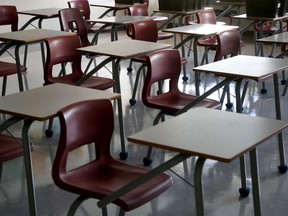Bennett: Why it's time to tackle the school ventilation problem
There's strong data on how heat waves affect learning. Add in a pandemic and the need to fix this problem grows more urgent.

Article content
Periodic heat-wave days can make in-person learning next-to-impossible, especially with COVID-19 still lurking in and around schools. Students and teachers in Quebec learned that, once again, when schools reopened briefly in June. Two school boards in the Outaouais were forced to declare two “heat days” and keep children out of classrooms.
What’s most surprising is that, until quite recently, few researchers had actually studied the effects of excessive heat on student learning. Now we know, more definitively, that heat exposure does adversely affect student learning and global warming will make it worse.
Two recent American studies not only confirm what we have long suspected, but make a compelling case for finally tackling the school ventilation problem.
The most influential research, led by R.J. Park and published in the May 2020 American Economic Journal, demonstrates that excessive heat disrupts learning time.
Using a sample of 10 million students in Grades 10 and 11 who retook the PSATs (Preliminary Scholastic Assessment Test), the U.S. researchers found that hotter days reduce scores, with extreme heat being particularly damaging to performance.
“Without air conditioning, a 1℉ hotter school year reduces the year’s learning by 1 per cent,” the researchers found. Hot school days also tend to have proportionately more adverse effects on minority students, accounting for some five per cent of the so-called “racial achievement gap.” In short, students from marginalized and racialized communities suffer the most.
A second study, released in March 2021 by two Oklahoma university researchers, produced similar findings in elementary and middle schools. Increasing average temperature levels in excess of 90℉ were found to adversely affect achievement on standardized Math and English/Language Arts tests in grades 3 to 8. Each additional day above 100℉ results in lower student achievement.
Park and his team also show that adaptation measures, such as air conditioning, can reduce the harmful effects of hot temperatures on student learning. School-level air conditioning penetration works to offset the heat’s effects on students. It is particularly beneficial in school districts or areas with average maximum temperatures below 84℉ where air cooling systems are less prevalent.
The pandemic has cost us most of two years of schooling, as school systems pivoted to home learning, hybrid models, back and forth, interrupting months of in-person schooling. Health risk reduction strategies are now part of school district facilities planning and maintenance practices. Reopening schools forced education authorities to become more aware of, and responsive to, the critical need to ensure healthy school buildings.
One of the best COVID-19 strategies, produced in June 2020 by the Harvard T.H. Chan School of Public Health, identified the five critical elements of an effective plan: 1) healthy classrooms; 2) healthy buildings; 3) healthy policies; 4) healthy schedules; and 5) healthy activities. “Breathing clean air in the school building” was deemed essential to the health and safety of students, teachers and staff during COVID-19 and in post-pandemic times.
Improving air ventilation was at the centre of the flexible response plan of action, tailored to the specific conditions in each school site. Beyond merely increasing outdoor air ventilation, the Chan public health team’s remedial actions included air quality assessments, portable air cleaners, filtering of indoor air, and the installation of central or designated zone air conditioning.
The pandemic was a wake-up call for educators, alerting us to the critical role played by air flows and aerosols in the transmission of deadly viruses. Growing awareness of climate change and global warming has also heightened our sensitivity to rising temperatures and the incidence of heat waves. Median climate change scenarios predict average U.S. warming at 5 ℉ from 2010 to 2050.
It’s safe to predict that by 2050 there will be more school days in the high 30s (Celsius) with sweltering Humidex readings. Given those climate change prospects and what COVID taught us, investing in improved school ventilation, including air conditioning, looks like a sensible, longer-term capital improvement in K-12 education.
Putting up with oppressive heat and making do with existing air ventilation is becoming less defensible in COVID times. Let’s hope the pandemic breaks the educational gridlock for the sake of today’s students and teachers.
Paul W. Bennett, Ed.D., is Director of the Schoolhouse Institute in Halifax, Adjunct Professor of Education, at Saint Mary’s University, and the author of The State of the System: A Reality Check on Canada’s Schools (2020).






Postmedia is committed to maintaining a lively but civil forum for discussion. Please keep comments relevant and respectful. Comments may take up to an hour to appear on the site. You will receive an email if there is a reply to your comment, an update to a thread you follow or if a user you follow comments. Visit our Community Guidelines for more information.